A Smith’s-Eye View from Korea on Army Headquarters Reduction

The Budget Control Act’s (BCA) guillotine is poised to slice off part of America’s ground combat brain with across-the-board 25-percent cuts to Army headquarters. In addition to smaller staffs, active duty billets in those headquarters are to be replaced by part-time reservists and guardsmen.
Conrad Crane and John Bonin have intervened in this process with a recent War on the Rocks article (“The Next Task Force Smith: The Danger of Arbitrary Headquarters Reductions”), pointing out history’s verdict on this downsizing activity and skillfully showing what the cleaver hath wrought. Their assessment finds that in the post-war rush to make efficiency gains through staff reduction, the United States always, literally always, has paid with initial combat ineffectiveness in the next war. Crane and Bonin’s lesson — less is not more: “The harsh reality is that modern warfare requires big headquarters.” Their essay’s title invokes the sad experience of a tactical headquarters in Korea, “the Army’s metaphor for lost readiness” — Task Force Smith, circa 1950.
But what of another tactical headquarters in Korea — the 2nd Infantry Division, circa 2015, where I currently serve? These soldiers are the modern embodiment of Crane and Bonin’s military ghost story, which raises the question: What is the “Smith’s-Eye” view of Army headquarters reduction from the Korean Peninsula?
Not positive, because the intended broad cut and generic design does not account for the 2nd Infantry Division’s unique posture, partnership, or plethora of potential missions.
The 2nd Infantry Division is America’s only Army division forward-stationed in a foreign country in close proximity to enemy forces. This position drastically reduces the time available in crisis to prepare for war and so the unit’s mission is to always be prepared to “Fight Tonight.” As Lawrence Freedman reminds us, “deterrence works; until it doesn’t,” and North Korea is anything but predictable. Backfilling active duty staff with reserve component soldiers, who must be mobilized after a crisis has begun, will jeopardize early efforts to provide command and control in a shooting war in Korea. This reserve component solution is a Band-Aid to a headquarters head wound, applied 90 days post-op — it may help a little, but clearly lacks sufficiency and timing. One soldier on the peninsula, today, is worth two off, someday.
In such a war, the 2nd Infantry Division will fight alongside the Republic of Korea (ROK) Army. While the U.S. military’s recent experience in Iraq and Afghanistan suggests liaison burdens typically fall to other countries, oppositely, in Korea, the U.S. military is the smaller allied force, with roughly 30,000 U.S. troops standing alongside over 600,000 ROK Army active ground forces, in addition to 3.5 million ROK reservists on standby for war. This might be called “Pershing’s problem,” harkening back to World War I’s American Expeditionary Force (AEF) commander, Gen. John J. Pershing, whose challenge was to integrate the AEF into a significantly larger international force. And cross-cultural, war-winning trust is not built overnight, via email, or to be surged in a crisis. It is found in persistent relationship building, one firm handshake at a time. No other U.S. division faces this challenge, every day.
On top of this, the 2nd Infantry Division is required to perform a truly unique range of missions. In the words of Georgetown’s David Maxwell, the North Korean threat is vast and wide: “guerilla warfare, conventional forces, chemical weapons, nuclear weapons and ballistic missiles, and more.” Just one mission set alone — Countering Weapons of Mass Destruction — requires a complete, robust headquarters staff, prepared on nearly no notice to deliver tactical and operational outcomes in support of strategic objectives. Quarterbacking war in Korea will be complex; success will be harder with a weakened quarterback.
Both historical evidence and modern concern counsels we ought to do all we can to forestall the BCA’s blade. Fortunately, it appears the uniformed leadership is uniformly in support — the new chief of staff of the Army’s primary imperative is to support “readiness,” echoing the 2015 National Military Strategy, which “places special emphasis on maintaining highly ready forces forward.” The time is right to knock this guillotine off its intended headquarters victim in Korea, to ensure what everyone wants: There will never be a “next” Task Force Smith.
Major Matt Cavanaugh, a U.S. Army Strategist, has served in assignments from Iraq to the Pentagon, and New York to New Zealand. A Contributor at War on the Rocks, he looks forward to connecting via Twitter @MLCavanaugh.
This essay is an unofficial expression of opinion; the views expressed are those of the author and not necessarily those of the 2nd Infantry Division, U.S. Forces Korea, the Department of the Army, the Department of Defense, or any agency of the U.S. government.

